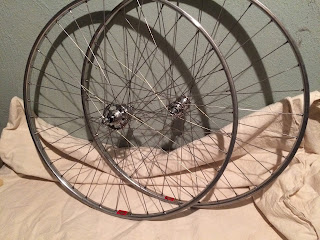Ahh, the 1950s. A simpler, more innocent time of sock hops and drive-ins, pig-tailed girls in their poodle skirts and saddle shoes, boys in letterman jackets, pompadours and penny loafers, and Greasers with hearts of gold. Bill Haley and the Comets were rockin' 'round the clock. We liked Ike.
Oh, wait -- that was
Happy Days.
The communist-fearing McCarthyist reality is probably a bit more complicated. The '50s hid a lot of ugliness under that scrubbed and sparking, lily-white suburban surface.
 |
This particular copy was distributed by the Stark County
Sheriff's Dept. in Ohio - but the manuals were available all
over America, "personalized" for various localities. |
Automobiles had been taking over the American roads for several decades, but in post-WWII America, the conquest became complete. The Axis powers surrendered to the U.S. in 1945 -- and soon after, the American people surrendered to the automobile. During the war, travel by bicycle made a brief resurgence, but by the 1950s, it was a fact of life that bicycles were for kids. Adults drove
cars.
The dominance of the automobile can be seen clearly in the safety films and educational materials of the day. In the
Bike Safety 101 series, I've looked at a lot of safety education films from that era, but today I thought I'd share a classic bit of anti-bicycling propaganda disguised as helpful safety advice: a 1953
Bicycle Death Safety Manual, brought to you by the fine folks of the Police Safety Council.
I've been searching to find out more about the Police Safety Council, but figuring out who exactly they were is difficult. All I know for sure is that they were located in Milwaukee and published a variety of safety manuals and pamphlets for American school children in the 1950s, and probably at least through the 1960s - and distributed them through local police and sheriff's departments across the country. There was a similar group called the Police Safety League, as well as a National Safety Council. With their similar missions, it's possible that these various groups merged into one over time, but I have nothing with which to substantiate that hunch. The safety manuals from these groups are all basically the same in that they all propagate virtually identical messages:
- Bicycles are for children.
- Riding a bicycle will get you killed.
- If a kid dies on a bicycle, it's
always the kid's own fault
- Drivers are not responsible, nor should they be
held responsible, for the deaths they inflict.
- Anyone who has any sense of self-preservation will get a driver's license and a car as soon as possible (and never look back).
 |
| "Plenty of speed -- no thought of danger." |
Just think about some of the ironies in the message. First, there's the obvious contradiction that bicycles are considered toys for kids, yet they are depicted as horrible death traps. Yes - we love our kids so much that we give them toys that we believe will
kill them.
Then there's the contradiction that a bicycle is a "means of transportation," and riders are responsible for following the rules of the road - yet the message one gets from these manuals is almost like a bicycling version of the
Dred Scott decision -- a cyclist has no rights that an auto driver is compelled to respect. If the cyclist's rights conflict with the auto driver's convenience, then the cyclist is out of bounds.
 |
| "Sad but true - another healthy boy meets his death." |
Don't forget the obvious distortion that Americans were (still are, to some extent) being fed by the Automotive Industrial Complex - that cars are
safe and bicycles are
dangerous - despite the fact that an average of 35,000 people died in car collisions each year in the U.S. through the decade of the 1950s - and that number grew to roughly 50,000 deaths per year in the 1960s. By way of comparison, the average of 35,000 vehicular deaths per year in the 1950s
seems almost identical to the number of vehicular deaths in recent years, but there's more to the figures. There were 35,000 people killed in automobiles in the U.S. in 2015. However, as a percentage of population, the carnage in the 1950s and '60s was well above what it is today. In the 1950s, the average per year was about 21 deaths per 100,000 people - compared with 11 deaths per 100,000 people in 2015. Compared with the average of vehicle miles traveled (VMT), the difference is even more stark. Throughout the 1950s, there was an average of 6 deaths per 100 mil. VMT. In 2015, that figure was about 1.12 deaths per 100 mil. VMT.
Kids get killed or permanently disabled on almost every single page of the
Bicycle Death Safety Manual making it pretty clear that being a bicyclist (or even a pedestrian, when you get right down to it) is potentially deadly -- but what gets virtually ignored is the fact that all these people are killed by
cars. Of course, nowhere is it even hinted that anything should be done about the cars or their drivers. It also never seemed to occur to anyone that providing better infrastructure to accommodate cyclists might help to make them safer (only a socialist would suggest such a thing). What does it say about a car-centric society when they are so willing to overlook all kinds of carnage as long as we don't put any extra restrictions on cars? It's so much easier (and profitable) to just keep blaming the victims.
 |
"John is making the mistake of riding in the center of the road. A bad piece of pavement suddenly appears. . . The suddenness and closeness make it impossible for the motorist to stop in time. Another death that might have been avoided."
Forget about "taking the lane," even if it means avoiding the doors of the parked cars. And is it just me who thinks that maybe the city bears some responsibility in keeping the roads in better condition? Or that the driver bears some responsibility for following so close to a cyclist who should have been very visible? |
 |
| "Mary will never walk again." |
 |
| "Another unnecessary death due to carelessness on George's part." Yes - George should signal before making a left turn - but he also shouldn't be expected to make his left turn from the far right side of the lane. But even more than that, what the hell is that car doing driving along just inches behind George's back wheel? Seems to me that poor George was going to die whether he made that left turn or not. Of course, it's not the driver's fault at all. |
 |
| "Beware of car doors opening and striking you." But whatever you do, don't stop hugging the right side curb. "Bill is shoved into the middle of the street and run over." |
 |
"The child is thrown to the pavement -- Skull fracture and death."
According to the manual, bicyclists were not only a danger to themselves, but a serious danger to others as well -- a belief that persists today. |
 |
| "Screeching brakes -- But too late -- Result -- a limp, lifeless body." |
 |
| "So engrossed in the plane she failed to watch the approaching automobile. Result -- She ran headon into the automobile, suffering severe injuries." |
 |
| "Unfortunately Jack is hit and killed instantly." |
Maybe because they had a few extra pages to fill, or perhaps because there wasn't enough death and dismemberment to go around with a bicycle-only manual, the PSL brings out a few other safety standbys to remind kids that they don't have to be on a bike to suffer a gruesome and untimely end.
 |
| Kids are run over while playing in leaf piles, electrocuted while flying kites, trapped in iceboxes, fall through floors, and blow themselves up with "chemicals." Life is good. |
 |
| And then there's "stranger danger." Don't take candy from strangers. If a creepy stranger approaches, hopefully he'll be wearing a very distinctive outfit, like mr. straw hat, dark jacket, and striped pants. And always remember that the policeman wants to be your friend. Oddly, mr. policeman is probably the creepiest-looking person on the page. |
Considering how many manuals like this one were distributed to schoolchildren around America in the '50s and '60s, it really is no wonder that bicycles were pushed off the streets, and that people are so willing to "blame the victims" when cars kill so many pedestrians and cyclists in addition to the tens of thousands of other motorists.
If only we could say things have gotten better. But propaganda like this is still out there, and the only real difference is that the quality of the graphics has gotten a little better. Remember
this beauty?
 |
The City of Phoenix Dept. of Transportation created these glorious "Bicycle Safety" death manuals last year. |
Yeah - we're still screwed up.
 As always, before I start building wheels, I refresh my memory by reviewing Jobst Brandt's excellent book, The Bicycle Wheel. Sheldon Brown's article on wheelbuilding is a good reference for anyone who doesn't have a copy of Brandt's book.
As always, before I start building wheels, I refresh my memory by reviewing Jobst Brandt's excellent book, The Bicycle Wheel. Sheldon Brown's article on wheelbuilding is a good reference for anyone who doesn't have a copy of Brandt's book.




























